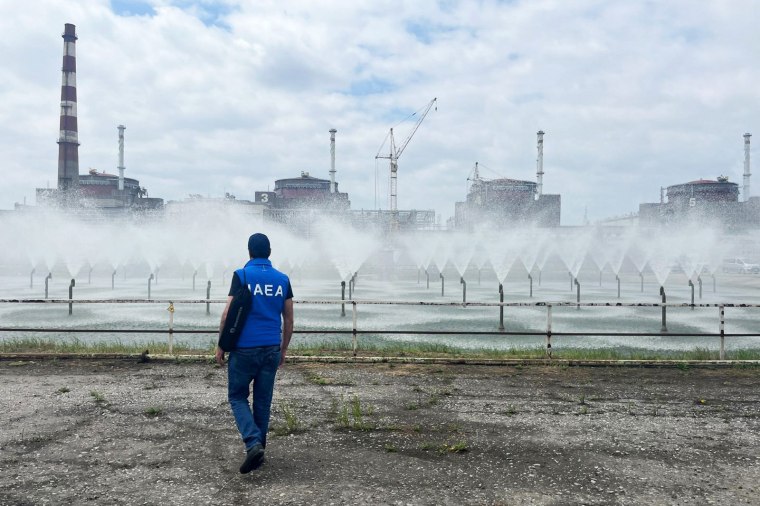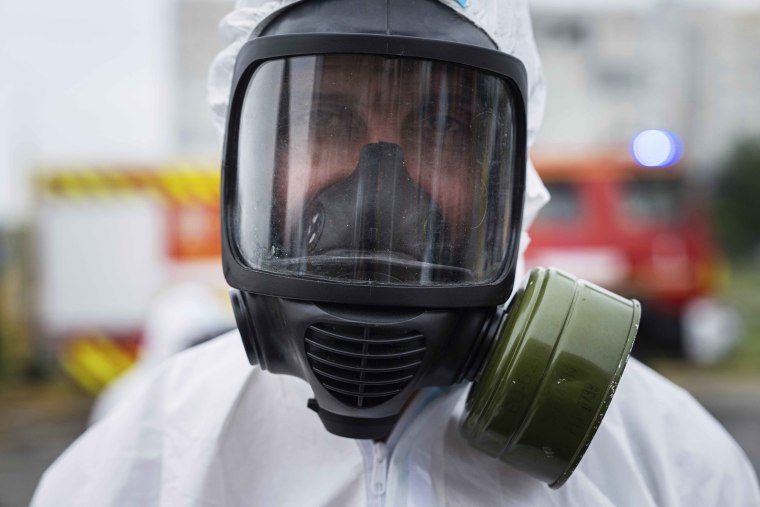It looks like an apocalyptic nightmare: Europe’s largest nuclear power plant stuck in the middle of a war zone, now wired with explosives ready to spread a radiological disaster across the continent.
Ukraine’s Zaporizhzhia nuclear power plant has been a constant source of dread since it was captured by Russia at the start of its invasion in March last year. A drumbeat of warnings from Kyiv and Moscow has grown in recent weeks, crescendoing Tuesday night, with each side accusing the other of planning an imminent attack designed to frame its belligerent rival.
The increasingly drastic warnings have fueled growing concern among people in southeastern Ukraine and beyond, especially given the destruction of the huge dam that had previously been a source of alarm and dread. similar charges. But some experts told NBC News the risk of a widespread radiation leak was low.
“It’s actually quite difficult to stage a meaningful reactive incident here,” said Pavel Podvig, a senior fellow at the UN Institute for Disarmament Research in Geneva. “Even if you try to detonate it, I don’t think you can spread” the radiation beyond a few hundred meters.
‘New evil?’
Ukraine has warned for months that Russia might try to blow up the nuclear power plant. But rarely have these warnings been as specific as On Tuesday evening, President Volodymyr Zelenskyy said Russia had placed “objects resembling explosives” on the roof – possibly with the intention of attributing an attack to Ukraine.
“It is the responsibility of everyone in the world to stop it,” he said, his final plea for more help from allies. “No one can stay away because radiation affects everyone.”
The Kremlin presented its own version of events.
President Vladimir Putin’s spokesman Dmitry Peskov said on Wednesday that the Russian-controlled plant was at risk of being “sabotaged” by Ukraine. Deputy adviser to Russian energy giant Rosenergoatom Renat Karchaa said Ukraine planned to hit the plant with a tactical ballistic missile equipped with a warhead filled with nuclear waste, the news agency reported on Tuesday. Russian RIA Novosti.
NBC News has not verified the claims from either side.
The International Atomic Energy Agency has issued regular warnings about the danger of fighting around a nuclear power plant. He said in a statement on Friday that partial inspections revealed no traces of mines or other explosives, but he was not allowed access to the entire site.

This part of the world does not need to imagine what a nuclear disaster looks like.
About 340 miles northwest of Zaporizhzhia, the Chernobyl nuclear power plant meltdown in 1986 still remains the worst of its kind on record.
Some 200,000 people have been evacuated, radioactive material has been blown into the northern hemisphere and scientists say a 19-mile exclusion zone may not be safe for 24,000 years, the half-life of plutonium- 239 released. Although officially less than 50 people died, the collapse led to a “far higher than normal” rate of thyroid cancer among children in the region, according to the IAEA.
Comparisons are then inevitable, especially since Zaporizhzhia is almost twice the size of Chernobyl and is in the midst of a modern ground war.

Many residents of eastern Ukraine have felt growing panic this week, fueled by a fervent rumor about the popular messaging app Telegram, which is being checked overnight by some locals.
The country’s deputy defense minister, Hanna Maliar, said on Wednesday that emergency services in four regions had undergone days of additional training to deal with “a possible terrorist attack” on the plant.
Those fears were hardly tempered last week when Russian-installed local government officials said they had evacuated 1,600 people, including 660 children, from the area around the plant.
The region has also seen what happens when a colossal piece of vital infrastructure is destroyed.
Last month, further down the Dnieper, the Kakhovka dam burst, apparently as a result of an explosion, flooding homes and forcing thousands to flee while threatening an “ecological disaster”.
Zelenskyy himself has said the muted international reaction to this – he blames Russia but his allies have not publicly assigned blame – “could incite the Kremlin to do further evil”.
